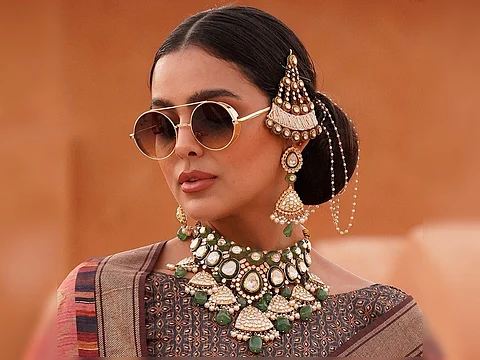
- Destinations
- Experiences
- Stay
- What's new
- Celebrating People
- Responsible Tourism
- CampaignsCampaigns
- Subscribe
- Buy Now

For centuries, Indian jewellery has mesmerised the world with its intricate craftsmanship and opulent appeal. Among the many traditional styles that continue to captivate collectors and connoisseurs alike, Kundan Meena stands out for its lavish artistry and cultural legacy. At the heart of many of these striking pieces lies a gleaming element that steals the show—Polki.
Polki, a flat, chip-like diamond, is a precious stone that is used during the jadayi process in Kundan Meena jewellery. It has gained much acclaim among brides of the day because of its royal appeal, vintage charm, and uncut diamond brilliance.
Each polki piece is unique because they are generally cut to follow the original structure of the stone. Polki is also one of the oldest forms of cut diamonds that date back to a time before the western methods were developed. What makes polki so expensive is the fact that it is the purest forms of diamonds.
"Modern brides often lean towards Polki sets for their wedding day as they prefer the natural diamond look over the enamel detailing of Kundan-Meena," said Abhishek Gilara, Managing Director at the House of Rambhajos in Jaipur.
While dealing with polki, jewellers work with various techniques including jadau, badroom and takkar. Each requires a separate skill set that is unique to the setting and technique.
Jadau is the Hindi word for embedding and refers to a pieces where polki is placed on a silver or gold foil. This renders it a shine and the piece glistens in light.
The badroom technique is a type of Polki jewelry setting where polki diamonds are embedded into a tulle or jaali pattern, using 24K gold.
The third is the takkar polki setting where the uncut diamonds are placed edge to edge without being packed by any metal. Putting together a jewellery piece using the takkar setting can take anywhere between one to two months since the diamonds have to cut and shaped to the same size and shape.
This craft requires a great amount of skill and dedication, and each piece takes days or even months to be completed, depending on the intricacy of the design.
"Polki pieces are timeless. Like Kundan Meena, it not only a great addition to your jewellery kit but also a great possession to hand down to the coming generations," said Gilara. While Jaipur leads the Polki market, Jodhpur and Bikaner are also recognised hubs.
However, Gilara also mentioned that while Polki is dominating the bridal trousseau because of its timelessness and elegance, Kundan Meena has not lost its relevance and continues to be a statement piece for Marwari and Rajasthani brides.
He also mentioned that the versatility of a Kundan Meena ornament with a gold polki front and a meenakari back makes it a two-in-one piece, also making it a fitting choice for multiple occasions and celebrations post-marriage.
